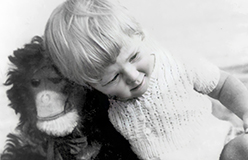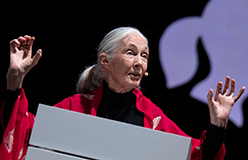Imagine living in a tent in the jungle. You rise at dawn. You hike deep into the jungle.
You sit quietly or move about slowly. All day. Waiting. By yourself. Alone. No conversation. No human contact. Just waiting. Waiting. Waiting. Waiting to spot a chimpanzee. Then, at dusk, you return to your tent. The next day you do it all over again.
This was Jane Goodall’s life at Gombe for six months. One hundred and eighty plus days. Then finally it happened. A chimpanzee came out to a clearing where Jane was sitting. The chimp saw Goodall. It did not run away. That moment marked the beginning of a lifetime of work.
At the time Goodall began her work with chimpanzees, scientists had very definite understandings about them. That they were “lower creatures.” That they were pre-programmed animals. That they lived by their instincts. Not their intelligence. The president of the Royal Anthropological Institute in London had earlier made the statements below about chimps. (Anthropology is the study of humanity.) ▶

The ape employs both sticks and stones as missiles and as hammers to crack the shells of nuts. But we have no evidence that he ever selects special forms for special uses. It is this which so essentially distinguishes man from the lower creation. Man is the tool-using animal.
The first chimp that approached Goodall was a male. He had hair on his face. So Goodall named him David Greybeard. Goodall watched the chimp. He used a blade of grass to pull termites out of a termite mound. It was much like how a person would use a spoon. On another day, she watched David Greybeard. He pulled a leaf off a twig to make a “new and improved” tool. He used the tool for termite fishing. Goodall wrote notes. She described the groundbreaking discoveries she had observed. An animal (other than a human) had made and used a tool. ▶


◀ David Greybeard was one of the first chimpanzees that allowed Goodall to follow and observe him. One day she was sitting next to him in the jungle. Goodall offered the chimp a ripe palm nut. She knew he liked them. The chimp didn’t take the nut from Goodall. Instead . . .
He looked directly into my eyes, took the nut, dropped it and with the same gesture, squeezed my hand, the way chimpanzees reassure each other. At that moment we communicated perfectly in a gestural language; I knew that he didn’t want the nut but that he appreciated my offer. I still treasure that moment because it was when I realized I had to dedicate my life to helping the chimps.
The longer Goodall observed the chimps, the more she learned. And the more she understood about them. Chimps were much closer to human beings than anyone else of her day had acknowledged. Here are some of the actions and behaviors she observed.

▲ Here, a chimp uses a leaf as a drinking tool to scoop up water. Chimps in different parts of Africa make different tools and use them differently. This suggests that tool-making and tool-use are learned behaviors, not instinct.

▲ Chimps spend a lot of time grooming each other. Grooming is removing dirt, bits of plants, dried skin, and bugs from the skin and fur. It is done for cleanliness. It’s also done for relaxation and bonding.

▲ Young chimps wrestle each other for fun. Young female chimps use sticks as simple dolls and care for them.

▲ Chimps were thought to be vegetarians. But Goodall observed them hunting and eating meat.

▲ Chimps experience joy, sadness, and anger. They can be jealous. They can be compassionate. Their feelings may show on their faces or in their bodies. Or in how they relate to one another. Can you tell which feelings are being expressed in these pictures?

▲ Chimps can become violent. Especially if the outcome means they can get access to needed resources. These include food, water, and shelter.
After Goodall had worked at Gombe for two years, Leakey helped her attend the University of Cambridge, in England. He knew that her work would never be taken seriously if she didn’t have a degree. In 1966, she earned a Ph.D. At last she had a degree connected to her work. However, while writing her thesis on her chimpanzee research, Goodall had faced sharp criticism from her science professors. Below is what she said about the experience. ▶

My professors told me I had done everything wrong; I shouldn’t have given the chimps names. Numbers were more scientific. I couldn’t talk about their personalities, mind, or emotions because those were unique to us. And, I certainly couldn’t talk about emotions like happiness or sadness. That was the guilty, guilty sin of anthropomorphism. But fortunately I had this teacher when I was a child, that was my dog Rusty, and I knew that the professors were wrong.

◀ In 1965, National Geographic made a film, Miss Goodall and the Wild Chimpanzees. The film documented what Goodall had discovered about the chimps. Their struggle for leadership. Their gentle hugs. Their brutal hunting and killing. During an interview later in her life, Goodall recalled, “Gradually science had to change its attitudes. It wasn’t just me, they saw film.”
Reflection
Scientists doubted Goodall’s statements about chimps until they saw the film. Do you think they were justified? Why or why not? Tell about another way science has changed because of new evidence.




